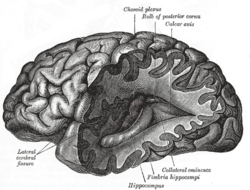Neurohistory
Neurohistory is an interdisciplinary approach to history that leverages advances in neuroscience to tell new kinds of stories about the past, but especially of deep history. It was first proposed by Harvard professor Daniel Lord Smail.[1] Other supporters include Lynn Hunt.[2]
Subsequent commentaries have shown that the idea relies on evolutionary assumptions (notably a blend of exaptation and the Baldwin Effect) and can be extended by drawing on ideas from neurophilosophy. The result has been suggested as providing the means for a new kind of historical method: history from within, which is conceived as an augmentation of history from below.[2]
References
- ↑ Smail, D. L. (2008) On Deep History and the Brain. Berkeley, CA: University of California Press
- 1 2 Burman, J. T. (2012). History from within? Contextualizing the new neurohistory and seeking its methods. History of Psychology, 15(1), 84-99. doi:10.1037/a0023500
This article is issued from Wikipedia - version of the 1/24/2016. The text is available under the Creative Commons Attribution/Share Alike but additional terms may apply for the media files.
